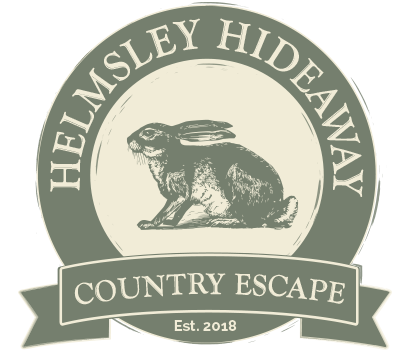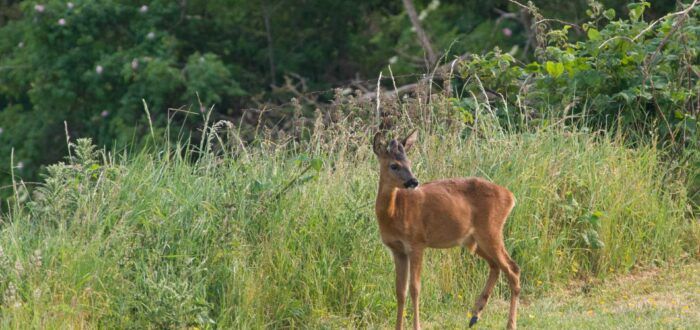The landscape across the North York Moors is quite varied from the rugged coast, across diverse heather moorland, to dense forestry, mature woodland to limestone grasslands, rivers and streams. This diverse and dramatic landscape hosts a huge variety of nature, wildlife, birdlife, flora and fauna.
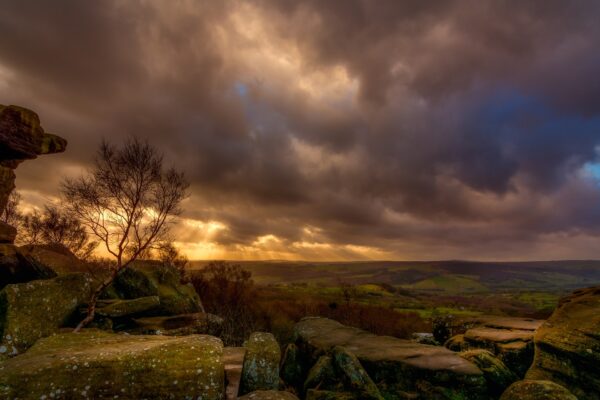
Moorland at Brimham Moor & Rocks
From soaring red kites, famous red grouse to fallow dear, otters, stoats and weasels, there is a huge variety of wildlife that can be discovered up on the North York Moors. More recently, the European beaver has been successfully re-introduced to Cropton Forest area and apparently thriving. You can head out on a boat safari on the Yorkshire coast for an opportunity to see dolphins, porpoises, great seals, various seabirds including puffin, guillemots and you may even spot minke whales.
Venture out into the North York Moors, take your binoculars and explore for yourself, you will probably stumble across some wondrous sights right on your path.
Here’s a selection of locations and inspirations that are pretty easily accessible and where you’ve got a pretty good chance of seeing some wonderful wildlife in some of the best natural surroundings that Yorkshire has to offer.
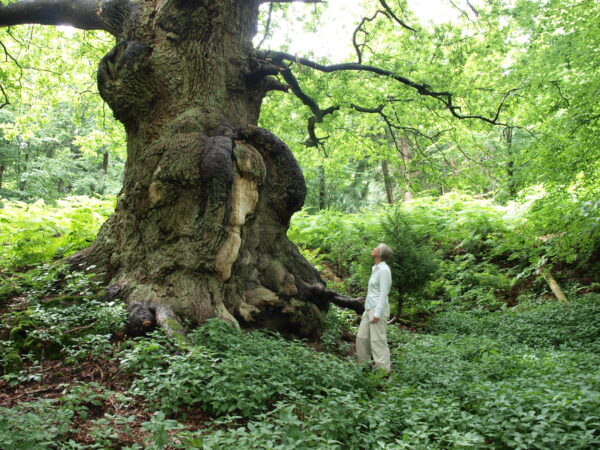
Old Oak Tree in the Deer Park at Duncombe Park
The Yorkshire Wildlife Trust has a number of nature reserves across the North York Moors, these include:
Duncombe Park National Nature Reserve, Nr. Helmsley
The parkland is part of the Duncombe Park estate and is in the River Rye Valley and just 1 mile south west of Helmsley. It is also very close to the National Centre for Birds of Prey. Duncombe Park is one of Yorkshire’s finest historic houses and estates and covers approx. 450 acres of superb gardens, parklands and this lovely nature reserve.
The Duncombe National Nature Reserve is well known site for its ancient woodland which hosts varied fungi and rare invertebrates. The local habitat is home to a number of scarce breeding birds such as Pied Flycatcher, three different species of Woodpecker, nuthatch and the elusive Hawfinch. The ancient woodland provides a wonderful walk around these grounds.
Garbutt Wood Nature Reserve & Sutton Bank National Park
This nature reserve renowned for its colourful display of flowers in May and June can be found close to Sutton Bank National Park. The only natural lake in the National Park can be found here, and Lake Gormire can be seen from above at the stunning viewpoint up at Sutton Bank. You may well spot roe deer in amongst the ancient wildwoods. The well-stocked bird bistro attracts all sorts of birdlife, even turtle doves can be seen in spring and early summer.
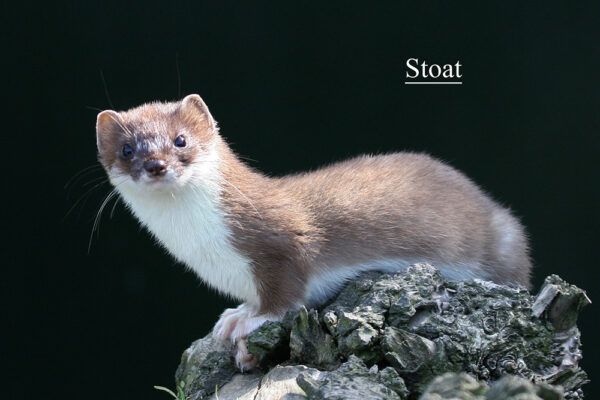
Woodland Stoat
Ashberry Nature Reserve
A beautifully clear stream which is fed by calcium rich springs runs right through this small reserve near Helmsley. It hosts freshwater shrimps and white-clawed crayfish. This valley hosts many rare plants and both fallow and roe enjoy visiting here too.
Fen Bog Nature Reserve
The mire bottom and bogland reserve contains a display of unusual colourful plants and mosses. Here lives many bright coloured butterflies, resplendent and large dragonflies, adders basking in the sun and warbling birdlife a plenty.
Forge Valley Wood National Nature Reserve
This reserve is one of the best examples of remaining ancient woodland within the North York Moors National Park. It is protected by a steep sided ravine and boast a huge amount of wildlife everywhere. Set on the banks of the River Derwent there is a geology trail that tracks the historic trail of the old forge where the woods were coppiced to provide charcoal to smelt the locally mined ironstone. Otters and crayfish be fpound here.
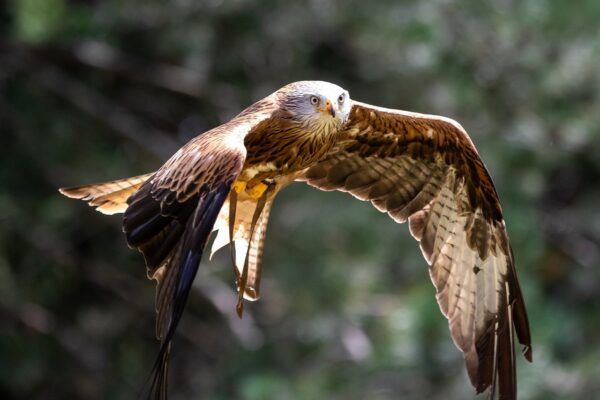
Red Kite in Flight
Spotting Birds of Prey
View Red Kites
The population of red kites continue to grow across the North Yorkshire and the North York Moors National Park. There are many mating pairs and sightings across many areas of the North York Moors, Red Kites have been seen at Harome and many near Helmsley too. Look out for red kites soaring and graceful gliding in the thermals and listen out for their distinct ‘whistling’ call. For more information in these beautiful birds of prey see the Yorkshire Red Kites website.
Raptor Viewpoint at Wykeham Forest
There’s a permanent Raptor Viewpoint in Wykeham Forest where you may see biords of prey such as merlin, goshawks, honey buzzards, common buzzards, red kite, peregrine, and sparrowhawks. The superb view over Troutsdale is well worth the visit and a worthwhile bonus.
National Centre for Birds of Prey
This centre houses the largest collection of birds of prey in the north of England. A number of these spectacular birds can be in flying demonstrations or take a Hawk Hike, Winter Owl Evenings or Raptor Experience. You can also see delights such as the tiny terrestrial Burrowing Owl, vultures to the Sea Eagle. Walk the grounds of Duncombe Park too.
Natures Trails, Bushcraft & Craft Workshops
There is a handy nature calendar includes a month by month guide to the best of the North York Moors’ wildlife. The events calendar offers seasonal walks, wildlife themed events, adventures and tips on where the best places to go, when and what wildlife and birdlife can be seen. Get yourself booked on.
Other tours available include:
- North Yorkshire Wildlife Tours & Photography – https://www.northyorkshirewildlife.co.uk/tours
- Yorkshire Coast Nature – https://www.yorkshirecoastnature.co.uk/tours-events
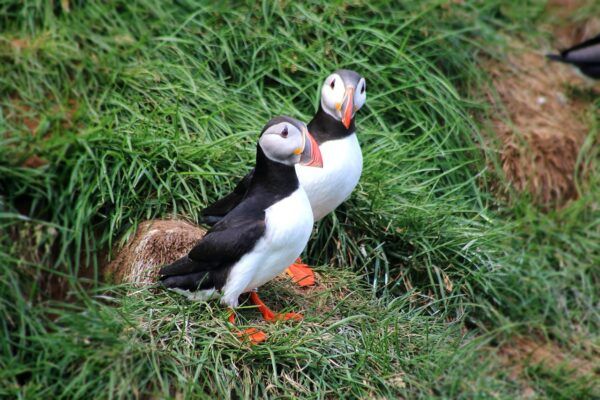
Colourful Puffins
North York Moors Coastline Wildlife & Sealife
The Summer and Autumn are the best times to spot the white-beaked dolphins and minke whales as they follow the food trail of mackerel and herring. The sea positively comes alive when these great shoals surface, a spectacular sight.
There are North Sea safaris that run from Whitby or Staithes that will help you find these great sights. Whitby Whale Watching run trips but only in September.
You do not have to head out to see to spot the common and grey seal colonies. They thrive beneath the cliffs along the North York Moors’ coastline. June and July are a good time to see the pups but please do not venture too close to them.
The high imposing cliffs also host a huge seabird colony where gannets, puffin, razorbills and kittiwakes can be found. There are also cruises that head out along the coastline giving you grandstand seats to watch the chalk cliffs and skies above which come alive with sea bird activity.
Of course you can never go far wrong with a spot of rockpooling along the coastline as the tide ebbs and flows. Leaving all sorts of wildlife delights behind.
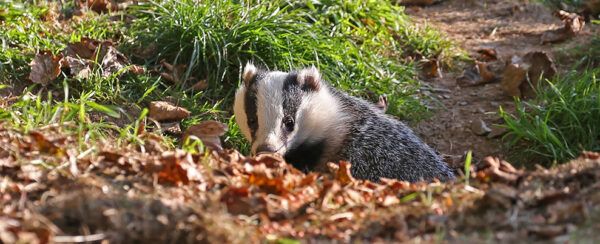
Woodland Badger
Wonderful Memories to Take Home
Whatever you choose and wherever you visit, the The North York Moors will throw up a wealth of wildlife and abundant natural habitats for you to experience. It will leave you with wonderful memories and you will want to be coming back to savour more.
Useful Links:
- Nature and Wildlife – Outdoor and Adventure in the Yorkshire Coast (discoveryorkshirecoast.com)
- Wildlife & Birdwatching – Yorkshire Coast Nature
- North York Moors Nature Calendar – https://www.northyorkmoors.org.uk/visiting/see-and-do/nature-calendar Mammals | Yorkshire Wildlife Trust (ywt.org.uk) – Fallow Deer, Muntjac Deer, Otters, Beaver and the rare Pine Marten
- Search different types of species – Wildlife Explorer | Yorkshire Wildlife Trust (ywt.org.uk)
- Yorkshire’s Wildlife – https://yorkshireswildlife.co.uk/north-yorks-moors.html
Related Posts:
- Local Walks around Harome – https://helmsleyhideaway.com/2023/01/lovely-local-walks-around-harome/
- Outdoor Activities – https://helmsleyhideaway.com/outdoor-activities/
- Local Area Guest Map – https://helmsleyhideaway.com/2023/06/interactive-guest-map-of-the-local-area-to-helmsley-hideaway/
